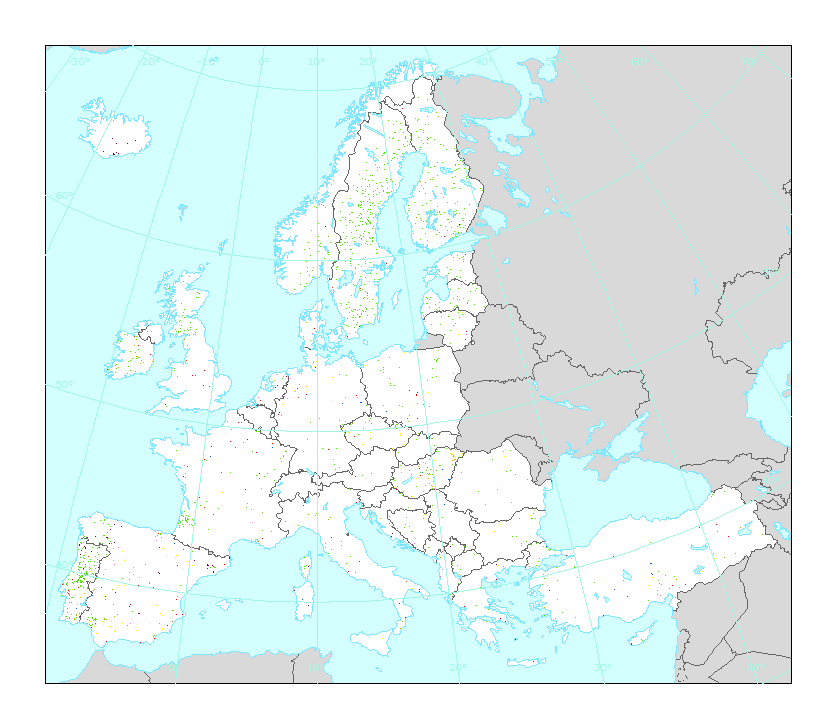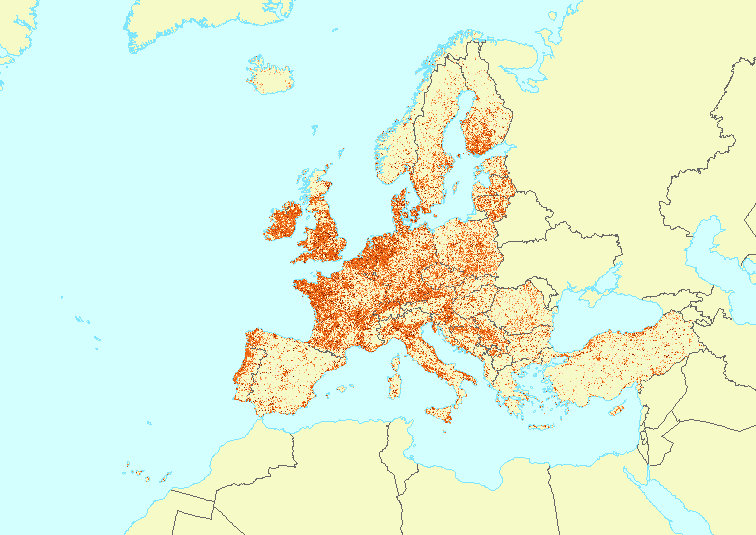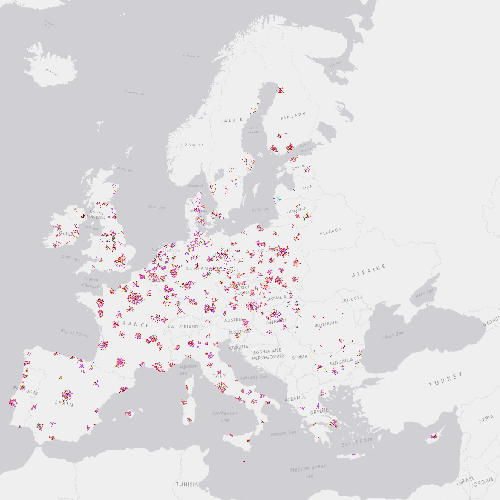IDP_DPSIR_Pressure
Type of resources
Available actions
Topics
INSPIRE themes
Keywords
Contact for the resource
Provided by
Years
Formats
Representation types
Update frequencies
Scale
Resolution
-

The raster dataset describes land cover flows between 2012-2018. Land Cover Flows summarize and interpret the 44x43=1892 possible one-to-one changes between the 44 CORINE land cover classes. The changes are grouped to so called flows of land cover and are classified according to major land use processes. The nomenclature of flows is organized on 3 hierarchical levels. See lineage on the nomenclature. The classification of land cover flows results from the feasibility studies and subsequent revisions after discussion with experts in agri-environment and forestry. Basically, the classification of land cover flows distinguishes change between broad land cover classes and changes internal to these classes. Analysis of land cover flows supplies a rapid vision of land use change processes taking place and they shed light on the drivers of various land use change processes such as e.g. urbanization. The geographic coverage of the dataset is EEA39 region.
-

The raster dataset describes land cover flows between 2000-2006. Land Cover Flows summarize and interpret the 44x43=1892 possible one-to-one changes between the 44 CORINE land cover classes. The changes are grouped to so called flows of land cover and are classified according to major land use processes. The nomenclature of flows is organized on 3 hierarchical levels. See lineage on the nomenclature. The classification of land cover flows results from the feasibility studies and subsequent revisions after discussion with experts in agri-environment and forestry. Basically, the classification of land cover flows distinguishes change between broad land cover classes and changes internal to these classes. Analysis of land cover flows supplies a rapid vision of land use change processes taking place and they shed light on the drivers of various land use change processes such as e.g. urbanization. The geographic coverage of the dataset is EEA39 region.
-

The raster dataset describes land cover flows between 2006-2012. Land Cover Flows summarize and interpret the 44x43=1892 possible one-to-one changes between the 44 CORINE land cover classes. The changes are grouped to so called flows of land cover and are classified according to major land use processes. The nomenclature of flows is organized on 3 hierarchical levels. See lineage on the nomenclature. The classification of land cover flows results from the feasibility studies and subsequent revisions after discussion with experts in agri-environment and forestry. Basically, the classification of land cover flows distinguishes change between broad land cover classes and changes internal to these classes. Analysis of land cover flows supplies a rapid vision of land use change processes taking place and they shed light on the drivers of various land use change processes such as e.g. urbanization. The geographic coverage of the dataset is EEA39 region.
-

The degree of urban dispersion (DIS) characterizes the settlement pattern in a geometric perspective and is based on the distances between any two points within built-up areas (average taken over all possible pairs of points, up to a maximum distance called the horizon of perception). DIS is input to the Weighted Urban Proliferation (WUP) metric, which has three components: the percentage of built-up areas (PBA), the dispersion of the built-up areas (DIS), and land uptake per person (LUP). The new urban sprawl metric, named "Weighted Urban Proliferation“ (WUP) is based on the following definition of urban sprawl: the more area is built over in a given landscape (amount of built-up area) and the more dispersed this built-up area is in the landscape (spatial configuration), and the higher the uptake of built-up area per inhabitant or job (lower utilisation intensity in the built-up area), the higher the degree of urban sprawl. The DIS dataset is used in EEA's Urban Sprawl work indicating urbanisation impacts on the land system. It covers EEA39.
-

The Urban Atlas provides pan-European comparable land use and land cover data for Functional Urban Areas (FUA). The Urban Atlas Change layers have become available from 2012 and only for all FUAs that have been covered in both 2006 and 2012 reference years. Urban Atlas is a joint initiative of the European Commission Directorate-General for Regional and Urban Policy and the Directorate-General for Enterprise and Industry in the frame of the EU Copernicus programme, with the support of the European Space Agency and the European Environment Agency.
-

Percentage of built-up area (PBA) measures how large the built-up areas are (in % of the landscape). PBA is a component of the new urban sprawl metric, named "Weighted Urban Proliferation“ (WUP). WUP is based on the following definition of urban sprawl: the more area is built over in a given landscape (amount of built-up area) and the more dispersed this built-up area is in the landscape (spatial configuration), and the higher the uptake of built-up area per inhabitant or job (lower utilisation intensity in the built-up area), the higher the degree of urban sprawl. Weighted Urban Proliferation (WUP) metric has three components: the percentage of built-up areas (PBA), the dispersion of the built-up areas (DIS), and land uptake per person (LUP). Values for landscapes of differing sizes can be directly compared because PBA is an intensive metric, i.e., the value does not depend on the size of the landscape. The PBA dataset is used in EEA's Urban Sprawl work indicating urbanisation impacts on the land system. It covers EEA39.
-

The degree of urban dispersion (DIS) characterizes the settlement pattern in a geometric perspective and is based on the distances between any two points within built-up areas (average taken over all possible pairs of points, up to a maximum distance called the horizon of perception). DIS is input to the Weighted Urban Proliferation (WUP) metric, which has three components: the percentage of built-up areas (PBA), the dispersion of the built-up areas (DIS), and land uptake per person (LUP). The new urban sprawl metric, named "Weighted Urban Proliferation“ (WUP) is based on the following definition of urban sprawl: the more area is built over in a given landscape (amount of built-up area) and the more dispersed this built-up area is in the landscape (spatial configuration), and the higher the uptake of built-up area per inhabitant or job (lower utilisation intensity in the built-up area), the higher the degree of urban sprawl. The DIS dataset is used in EEA's Urban Sprawl work indicating urbanisation impacts on the land system. It covers EEA39.
-

The raster dataset describes land cover flows between 2000-2018. The Land Cover Flows summarize and interpret the 44x43=1892 possible one-to-one changes between the 44 CORINE land cover classes. The changes are grouped in so called flows of land cover and are classified according to major land use processes. The nomenclature of flows is organized on 3 hierarchical levels. See lineage on the nomenclature. The classification of land cover flows results from the feasibility studies and subsequent revisions after discussion with experts in agri-environment and forestry. Basically, the classification of land cover flows distinguishes change between broad land cover classes and changes internal to these classes. Analysis of land cover flows supplies a rapid vision of land use change processes taking place and they shed light on the drivers of various land use change processes such as e.g. urbanization. The geographic coverage of the dataset is EEA39 region.
-

Urban Permeation (UP) is a measure of the permeation of a landscape by built‑up areas; it describes the degree to which the landscape is permeated by patches of built-up area. It is calculated from the new urban sprawl metric "Weighted Urban Proliferation“ (WUP). Weighted Urban Proliferation is based on the following definition of urban sprawl: the more area is built over in a given landscape (amount of built-up area) and the more dispersed this built-up area is in the landscape (spatial configuration), and the higher the uptake of built-up area per inhabitant or job (lower utilisation intensity in the built-up area), the higher the degree of urban sprawl. The WUP metric has three components: the percentage of built-up areas (PBA), the dispersion of the built-up areas (DIS), and land uptake per person (LUP). UP is a product of PBA and DIS. It represents the spread of the built-up areas in the landscape. UP is expressed in urban permeation units per m2 of land (UPU/m2). The UP dataset is used in EEA's Urban Sprawl work indicating urbanisation impacts on the land system. It covers EEA39.
-

Urban Permeation (UP) is a measure of the permeation of a landscape by built‑up areas; it describes the degree to which the landscape is permeated by patches of built-up area. It is calculated from the new urban sprawl metric "Weighted Urban Proliferation“ (WUP). Weighted Urban Proliferation is based on the following definition of urban sprawl: the more area is built over in a given landscape (amount of built-up area) and the more dispersed this built-up area is in the landscape (spatial configuration), and the higher the uptake of built-up area per inhabitant or job (lower utilisation intensity in the built-up area), the higher the degree of urban sprawl. The WUP metric has three components: the percentage of built-up areas (PBA), the dispersion of the built-up areas (DIS), and land uptake per person (LUP). UP is a product of PBA and DIS. It represents the spread of the built-up areas in the landscape. UP is expressed in urban permeation units per m2 of land (UPU/m2). The UP dataset is used in EEA's Urban Sprawl work indicating urbanisation impacts on the land system. It covers EEA39.
 RUC Geo-Data catalogue
RUC Geo-Data catalogue